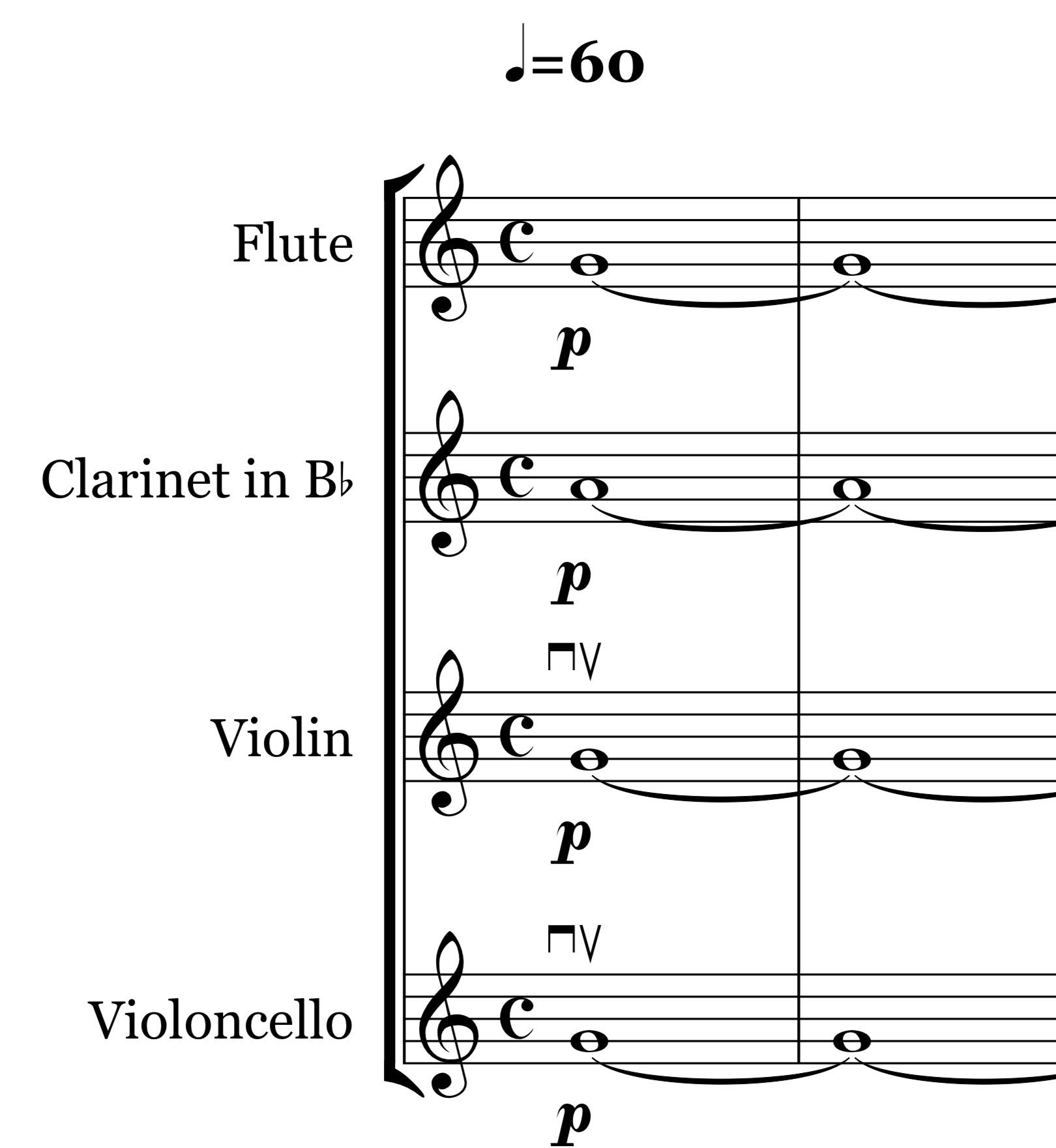












วิทยาลัยดุริยางคศิลป์ มหาวิทยาลัยมหิดล
College Of Music, Mahidol University

อจินไตย
2563
8 นาที 20 วินาที
Acinteyya
2020
8 minutes 20 seconds
ผมอยากจะสื่อให้เห็นถึงพระพุทธศาสนาด้วยเสียงดนตรีมาโดยตลอด ผมเติบโตในประเทศที่นับถือศาสนาพุทธ ศาสนาเป็นเครื่องยึดเหนี่ยวจิตใจของผมเสมอมา ไม่ว่าคุณจะเชื่อในหลักคำสอนของศาสนาหรือไม่ พระพุทธศาสนามีส่วนสำคัญต่อการดำเนินชีวิตของคนไทยอย่างหลีกเลี่ยงมิได้
I have always wanted to sonically portray Buddhism. Growing up in a Buddhist country, the religion has always been intriguing to me. Whether you believe in it or not, it is undeniable that Buddhism plays a significant role in many Thais' lives.
อจินไตย เป็นศัพท์ภาษาบาลีแปว่า สิ่งที่ไม่ควรคิด อจินไตย เป็นคำสอนทางพระพุทธศานาที่บอกชาวพุทธว่าสิ่งใดที่ไม่ควรคิดหรือพยายามที่จะเข้าใจด้วยตรรกะสามัญของปุถุชน อจินไตยมี 4 ประการ คือ หนึ่ง พุทธวิสัย วิสัยแห่งความมหัศจรรย์ของพระพุทธเจ้าทั้งหลาย สอง ฌานวิสัย วิสัยแห่งอิทธิฤทธิ์ สาม กรรมวิสัย วิสัยของกฎแห่งกรรม และสี่โลกวิสัย วิสัยแห่งโลก การมีอยู่ของสวรรค์ นรก แต่ละท่วงทำนองจะแสดงให้เห็นถึงสิ่งที่ไม่ควรคิดนี้ โดยในผลงานชิ้นนี้จะจัดเรียงลำดับใหม่ดังนี้ ท่วงทำนองแรกจะเป็นกรรมวิสัย ซึ่งจะแสดงให้เห็นถึงหลักการของกฎแห่งกรรม ทุกการกระทำย่อมนำมาซึ่งผลของการกระทำที่จะติดตัวเราไปจนตาย แม้ในบางครั้งเราจะมองไม่เห็นถึงผลของการกระทำนั้นก็ตาม ท่วงทำนองนี้สามารถแบ่งย่อยได้เป็น 3 ขั้น ผลกรรมที่ตามมาที่ชัดเจน ผลกรรมที่ตามมาไม่ชัดเจน และผลกรรมที่ซ่อนเร้น สิ่งที่ชัดเจนจะบรรเลงอยู่ในเบื้องหน้าของท่วงทำนอง ซึ่งก็คือระยะครึ่งขั้น ที่จะบรรเลงโดยเครื่องดนตรีประเภทเครื่องเป่า สิ่งที่ไม่ชัดเจนจะถูกบรรเลงโดยเครื่องเป่าเช่นกัน แต่จะมาในรูปแบบของจังหวะที่เกิจากความแตกต่างของตัวโน๊ต สุดท้ายสิ่งที่ซ่อนเร้นจะถูกบรรเลงโดยเครื่องดนตรีประเภทเครื่องสาย เริ่มแรกคุณจะรับรู้ได้ถึงความแตกต่างของดนตรี แต่เมื่อสิ่งที่ชัดเจนกว่ถูกบรรเลง คุณจะรับรู้ถึงความคล้ายคลึงมากขึ้น ท่วงทำนองที่สองจะเป็นฌานวิสัย ท่วงทำนองนี้จะแสดงให้เห็นถึงความเชื่อเรื่องของอิทธิฤทธิ์ของพระพุทธเจ้า หนึ่งในเรื่องราวที่ถูกเล่าขานสืบต่อกันมา แต่โบราณคือเรื่องของปุถุชนที่ปฏิบัติตามหลักคำสอนของพระพุทธศาสนาอย่างเคร่งครัด จนได้รับอิทธิฤทธิ์ เช่น เหาะเหินเดินอากาศ เดินทะลุผ่าสิ่งกีดขวาง ตกน้ำไม่ไหลตกไฟไม่ไหม้ ในท่วงทำนองนี้ คลาริเน็ตและเปียโนจะทำหน้าที่เปรียบดั่งไฟ เชลโล่เปรียบดั่งปุถุชน และไวโอลินเปรียบดั่งผู้เพียรในธรรมจนได้รับซึ่งอิทธิฤทธิ์ ท่วงทำนองี่สาม พุทธวิสัย ท่วงทำนองนี้จะถ่ายทอดพุทธประวัติของพระสัมมาสัมพุทธเจ้า ในศาสนาพุทธมีความเชื่อว่ามีพระพุทธเจ้าที่ล่วงมาเป็นจำนวนมากมายนับไม่ถ้วนที่จุติในอดีตชาติและอดีตภพ บทสวดมนต์ได้ถูกถอดโน๊ตมาเพื่อใช้เป็นดนตรีหลัก เครื่องดนตรีหลายๆชนิดจะถูกใช้เพื่อสื่อถึงการจุติของพระสัมมาสัมพุทธเจ้าในอดีตชาติและอดีตภพ ท่วงทำนองที่ 4 โลกวิสัย ท่วงทำนองนี้สื่อให้เห็นถึงความไม่แน่นอนของชีวิตหลังความตาย โดยท่วงทำนองนี้จะแบ่งออกเป็น 2 ช่วงย่อยๆ ได้แก่ ช่วงแรกคือโลก และช่วงที่สองคือนรกสวรรค์ ในช่วงแรกนักดนตรีจะได้รับคำแนะนำว่าให้เล่นโน๊ตตัวใด แต่ในช่วงที่สองนั้นนักดนตรีจะมีอิสระระดับหนึ่งในการอิมโพไวส์ เปรียบดังความมิหยั่งรู้เรื่องนรกและสวรรค์ของปุถุชน
Acinteyya is a Pali word which can be translated to inconceivable. Acinteyya is a Buddhist doctrine that tells the Buddhists what they should not be thinking about or trying to analyze; There are 4 of them. The first one is the power of Buddhas (Buddha- Visaya). The 2nd one is supernatural forces (Jhana-Visaya). The 3rd one is how karma works (Kamma-Vipaka). The last one is the existence of life after death (Loka-Cinta). Each movement will portray each forbidden thought. However, in this piece, the order has been rearranged. 1st movement “Kamma-Vipaka” This movement will portray the concept of karma. Everything we have done has consequences and they will follow us until we die, even though sometimes we cannot notice them. This movement can be separated into 3 layers, the obvious consequences, the not so obvious consequences, and the hidden consequences. The obvious one will be shown it the foreground of the movement i.e. a half-step dissonances that will be played by the woodwinds. The not so obvious one will also be played by the woodwinds, but this time they will come in a form of beating from the microtonal differences. Lastly, the hidden one will be played by the strings. You can clearly notice it in the beginning, but when the more obvious consequences come, it will be blurred. However, they are still there. 2nd movement “Jhana-Visaya” This movement will exemplify the belief of supernatural forces that Buddhism has. One of the most famous examples is that in the old time the people who practiced Buddhism hard enough will be granted superpowers such as the ability to fly, the ability to walk through solid objects, or the ability to be invulnerable to fire. In this movement, the clarinet and the piano will act as fire, the cello as a mortal man, and the violin as an attained practitioner that was granted the superpower. 3rd movement “Buddha-Visaya” This movement will tell a story about Buddhas. In Buddhism, there are countless Buddhas. However, they all exist in their times and universes. The Buddhas-Worshiping Chant was transcribed and set to be the main motif. Poly-tempo will be used to portray the existence of Buddhas that live in their times and universes. 4th movement “Loka-Cinta" This movement will depict the unknown of life after death. There are 2 small parts in this movement; the 1st part is life and the 2nd part is death. In the first part, players will be specifically told which notes to play. However, in the 2nd part, players will be granted a certain amount of freedom to improvise. This is to portray the absence of our knowledge about life after death